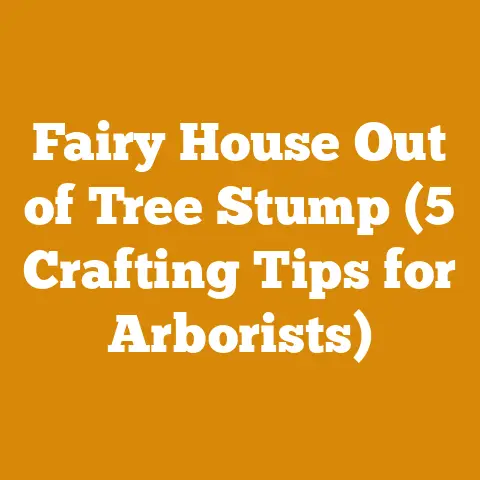Ant Killer for Trees: Effective Wood Pest Control Tips (5 Pro Hacks)
In the realm of wood processing and firewood preparation, the health and longevity of the trees that provide our raw materials are paramount.
Protecting these trees from pests, particularly ants, is a crucial aspect of sustainable wood management.
While ants may seem insignificant, certain species can cause significant damage to trees, impacting timber quality and overall forest health.
In this article, I’ll share my experiences and insights on identifying ant infestations, assessing the damage they cause, and implementing effective control strategies.
This isn’t just about killing ants; it’s about preserving the valuable resource that sustains our craft.
Ant Killer for Trees: Effective Wood Pest Control Tips (5 Pro Hacks)
Why Worry About Ants on Trees?
For many, ants are just a nuisance at picnics.
But in the world of forestry and wood processing, they can be a serious threat.
Some ant species don’t directly eat the wood, but their tunneling and nesting activities can weaken trees, making them susceptible to disease, fungal infections, and other wood-boring insects.
Other ant species, like carpenter ants, actively excavate wood to create their nests, causing structural damage that can ultimately lead to tree failure.
My Personal Experience: I once had a beautiful stand of oak trees that were severely infested with carpenter ants.
The damage was so extensive that several trees became unstable and had to be felled prematurely.
This experience taught me the importance of early detection and proactive ant control.
Key Concepts and Terminology
Before diving into the control methods, let’s define some key terms:
- Carpenter Ants ( Camponotus spp.): These are among the most destructive ants for trees.
They are large (1/4 to 3/4 inch long) and typically black or reddish-black.
Carpenter ants don’t eat wood but excavate it to create smooth, clean tunnels for their nests.
Look for piles of frass near tree trunks, branches, or entry points to their nests. - Pavement Ants (Tetramorium caespitum): While these ants primarily nest in the ground, they can also establish colonies in tree cavities or under loose bark.
- Argentine Ants (Linepithema humile): These ants are small (1/16 to 1/8 inch long) and brown.
They don’t directly damage wood, but their presence can attract other pests, such as aphids and scale insects, which can harm trees. - Acrobat Ants (Crematogaster spp.): These ants are small (1/8 to 1/4 inch long) and dark brown or black.
They get their name from their habit of raising their abdomens over their heads when disturbed.
Acrobat ants often nest in decaying wood or tree cavities.
Identifying Ant Damage:
- Carpenter Ant Damage: Look for smooth, clean tunnels in the wood, often following the grain.
Piles of frass near entry points are a telltale sign. - Other Ant Damage: Look for ant trails on the tree trunk and branches.
Check for nests in tree cavities or under loose bark.
Inspect the tree for signs of other pests, such as aphids or scale insects.
Case Study: I once inspected a large maple tree that was showing signs of decline.
Upon closer examination, I found numerous carpenter ant entry points near the base of the tree.
The ants had excavated extensive tunnels in the heartwood, weakening the tree’s structure.
I recommended removing the tree before it posed a safety hazard.
Hack #2: Assessing the Damage: Evaluating the Extent of the Infestation
Once you’ve identified the ant species and the type of damage, it’s essential to assess the extent of the infestation.
This will help you determine the appropriate course of action.
- Visual Inspection: Carefully examine the tree trunk, branches, and root flare for signs of ant activity, such as ant trails, entry points, and frass.
- Sounding: Use a rubber mallet or the handle of a screwdriver to tap on the tree trunk.
A hollow sound can indicate internal decay caused by ants or other pests. - Probing: Use a screwdriver or knife to probe into suspected ant entry points.
If the wood is soft and crumbly, it’s likely infested. - Professional Inspection: For severe infestations or large trees, consider hiring a certified arborist to conduct a professional inspection.
They have specialized tools and expertise to assess the extent of the damage and recommend appropriate treatment options.
Determining the Severity:
- Minor Infestation: A few ants and minimal damage.
Treatment may involve simple baiting or spot treatments. - Moderate Infestation: Numerous ants and noticeable damage.
Treatment may require more extensive baiting, insecticide applications, or tree pruning. - Severe Infestation: Extensive ant activity and significant damage.
Treatment may involve tree removal, soil treatment, and preventative measures to protect surrounding trees.
Data and Statistics: According to a study by the USDA Forest Service, carpenter ant infestations can reduce the structural integrity of trees by up to 50%.
This highlights the importance of early detection and effective control.
Hack #3: Natural Ant Control Methods: Non-Toxic Solutions
Before resorting to chemical insecticides, consider these natural and non-toxic ant control methods:
- Diatomaceous Earth (DE): This natural powder is made from fossilized algae.
It’s abrasive and dehydrating to insects, including ants.
Sprinkle DE around the base of the tree, in ant trails, and near entry points.
Make sure to use food-grade DE, as other types can be harmful.- Application Rate: Apply a thin layer of DE, about 1/8 inch thick.
- Frequency: Reapply after rain or watering.
- Borax and Sugar Bait: Mix borax (sodium borate) with sugar and water to create an attractive bait for ants.
The sugar attracts the ants, while the borax acts as a slow-acting poison.
Place the bait in shallow containers near ant trails.- Recipe: Mix 1 teaspoon of borax with 1/4 cup of sugar and 1 cup of warm water.
- Placement: Place bait stations in areas inaccessible to pets and children.
- Vinegar: Vinegar is a natural ant repellent.
Spray vinegar directly on ant trails and around the base of the tree.- Application: Use undiluted white vinegar.
- Frequency: Reapply as needed.
- Citrus Peels: Place citrus peels (orange, lemon, or grapefruit) around the base of the tree.
The oils in the peels are toxic to ants.- Placement: Scatter citrus peels around the tree’s drip line.
- Frequency: Replace peels every few days.
- Essential Oils: Certain essential oils, such as peppermint, clove, and tea tree oil, are effective ant repellents.
Mix a few drops of essential oil with water and spray on ant trails and around the base of the tree.- Recipe: Mix 10-20 drops of essential oil with 1 cup of water.
- Application: Shake well before spraying.
My Experience: I’ve had success using diatomaceous earth to control ants around my firewood stacks.
It’s a safe and effective way to keep ants from nesting in the wood.
Hack #4: Chemical Ant Control: Targeted Insecticide Applications
If natural methods are not effective, you may need to resort to chemical insecticides.
Choose insecticides carefully and always follow the manufacturer’s instructions.
- Contact Insecticides: These insecticides kill ants upon direct contact.
They are effective for spot treatments but may not eliminate the entire colony.
Examples include pyrethrins and permethrin.- Application: Spray directly on ants and ant trails.
- Safety Precautions: Wear gloves, eye protection, and a respirator when applying contact insecticides.
- Systemic Insecticides: These insecticides are absorbed by the tree and distributed throughout its tissues.
They are effective for controlling ants that feed on the tree’s sap or wood.
Examples include imidacloprid and dinotefuran.- Application: Apply as a soil drench around the base of the tree.
- Timing: Apply in the spring or fall when the tree is actively growing.
- Caution: Systemic insecticides can harm beneficial insects, such as bees and butterflies.
Use them sparingly and only when necessary.
- Insecticidal Baits: These baits contain a slow-acting poison that ants carry back to the colony, eventually killing the entire nest.
They are effective for controlling large ant populations.
Examples include fipronil and hydramethylnon.- Placement: Place bait stations near ant trails and entry points.
- Monitoring: Check bait stations regularly and replenish as needed.
Important Considerations:
- Target Specificity: Choose insecticides that are specifically labeled for ant control.
- Environmental Impact: Select insecticides with low toxicity to non-target organisms, such as birds, bees, and other beneficial insects.
- Resistance: Rotate insecticides with different modes of action to prevent ants from developing resistance.
- Professional Application: For large trees or severe infestations, consider hiring a professional pest control service to apply insecticides safely and effectively.
Tool Specifications: When applying insecticides, use a high-quality sprayer with adjustable nozzle settings.
A backpack sprayer is useful for treating large areas.
Hack #5: Preventative Measures: Maintaining Tree Health and Reducing Ant Attraction
Prevention is always better than cure.
Here are some preventative measures to keep ants away from your trees:
- Maintain Tree Health: Healthy trees are less susceptible to ant infestations.
Provide adequate water, fertilizer, and pruning to keep your trees strong and vigorous.- Fertilization: Use a balanced fertilizer with nitrogen, phosphorus, and potassium.
- Pruning: Remove dead, damaged, or diseased branches to improve air circulation and reduce potential nesting sites for ants.
- Remove Debris: Clear away fallen leaves, branches, and other debris from around the base of the tree.
These materials can provide shelter and nesting sites for ants. - Seal Cracks and Cavities: Seal any cracks or cavities in the tree trunk or branches with tree sealant or caulk.
This will prevent ants from entering and nesting inside the tree. - Control Aphids and Scale Insects: Ants are attracted to the honeydew produced by aphids and scale insects.
Control these pests to reduce ant attraction.- Insecticidal Soap: Spray trees with insecticidal soap to control aphids and scale insects.
- Horticultural Oil: Apply horticultural oil in the dormant season to smother overwintering pests.
- Monitor Regularly: Inspect your trees regularly for signs of ant activity.
Early detection and treatment can prevent minor infestations from becoming major problems. - Proper Wood Storage: If you’re storing firewood near trees, keep it elevated and away from the tree trunks.
This will prevent ants from moving from the firewood to the trees.
Firewood Stacking Case Study: I use a raised platform to store my firewood, which keeps it off the ground and reduces moisture buildup.
This also makes it less attractive to ants and other pests.
I also leave a gap of at least 10 feet between the firewood stack and any trees to prevent ants from migrating.
Strategic Insights: Implementing an Integrated Pest Management (IPM) approach is crucial for long-term ant control.
IPM combines various methods, including cultural practices, biological controls, and chemical controls, to minimize environmental impact and prevent pest resistance.
Additional Tips and Considerations
- Consider the Time of Year: Ant activity is typically highest in the spring and summer.
Adjust your control efforts accordingly. - Be Patient: Ant control can take time and persistence.
Don’t expect to see results overnight. - Document Your Efforts: Keep records of your ant control activities, including the date, method used, and results.
This will help you track your progress and adjust your strategy as needed. - Consult with Experts: If you’re unsure about how to control ants on your trees, consult with a certified arborist or pest control professional.
Cost Estimates: The cost of ant control can vary depending on the severity of the infestation and the control methods used.
Natural methods, such as diatomaceous earth and borax bait, are relatively inexpensive.
Chemical insecticides can be more costly, especially if you hire a professional to apply them.
Tree removal can be the most expensive option, but it may be necessary for severely damaged trees.
Safety Standards: Always follow safety guidelines when handling insecticides or operating power tools.
Wear appropriate personal protective equipment (PPE), such as gloves, eye protection, and a respirator.
Keep children and pets away from treated areas.
Challenges Faced by Global DIYers and Small-Scale Logging Businesses:
- Access to Resources: In some parts of the world, access to insecticides or professional pest control services may be limited.
- Cost: The cost of ant control can be a significant burden for small-scale logging businesses.
- Knowledge and Expertise: DIYers may lack the knowledge and expertise to effectively control ants on their trees.
- Environmental Concerns: Some DIYers may be hesitant to use chemical insecticides due to environmental concerns.
Addressing these challenges:
- Identify the Ant Species: Determine the specific ant species infesting your trees.
- Assess the Damage: Evaluate the extent of the infestation and the damage it has caused.
- Choose Your Control Method: Select the appropriate control method based on the severity of the infestation and your personal preferences.
- Gather Your Supplies: Collect the necessary tools and materials, such as diatomaceous earth, borax, vinegar, essential oils, insecticides, sprayers, and personal protective equipment.
- Implement Your Plan: Follow the instructions carefully and apply the chosen control method to the affected trees.
- Monitor Your Progress: Check the trees regularly for signs of ant activity and adjust your strategy as needed.
- Prevent Future Infestations: Implement preventative measures to keep ants away from your trees in the future.
By following these steps, you can effectively control ants on your trees and protect your valuable wood resources.
Remember that patience and persistence are key to success.
Conclusion
Protecting trees from ant infestations is an essential aspect of sustainable wood processing and firewood preparation.
By understanding the different ant species, assessing the damage they cause, and implementing effective control strategies, we can preserve the health and longevity of our trees and ensure a continuous supply of high-quality wood.
Whether you’re a hobbyist, a small-scale contractor, or a large-scale logging business, the tips and techniques I’ve shared in this article will help you keep your trees healthy and pest-free.
Remember, a healthy forest is a productive forest, and a productive forest is the foundation of our craft.






